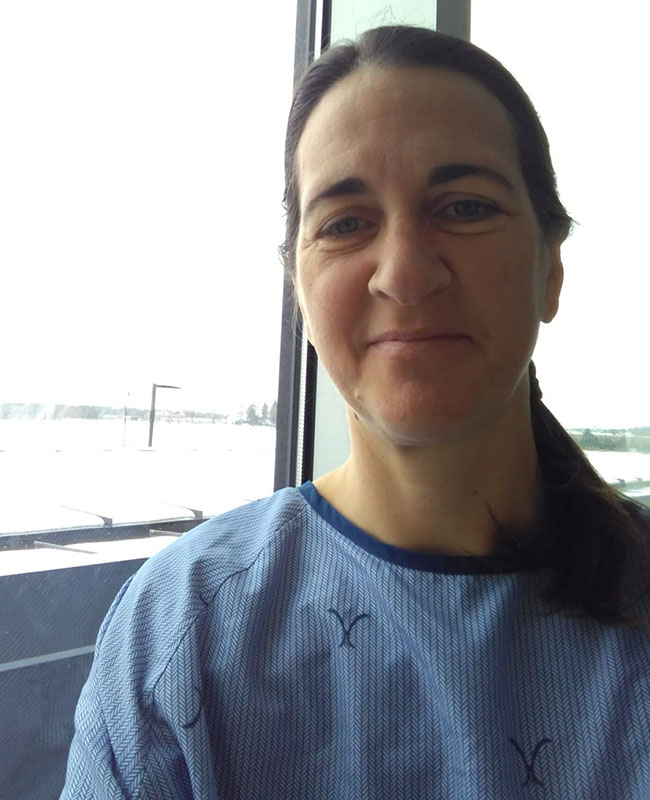Just more than a year ago, Julie Kerkhof underwent emergency surgery for a twist in her large intestine — known as a cecal volvulus — that expanded while waiting for care. The result was the loss of half of her colon.
The procedure was the start of a rushed journey of recovery that endangered her long-term health.

Within six weeks, Kerkhof returned to work early as one of a limited number of registered community nurses at St. Joseph’s Health Centre in Guelph, Ontario.
But without the recommended level of postoperative care, she said it was difficult to adjust to the requirements of her job. As a result, she soon burned out and went on another 15-week leave. It ended in late October 2023.
Even now, Kerkhof says she continues to suffer postoperatively. She was diagnosed with gastritis on Nov. 21 and has been experiencing drastically reduced energy levels and pain.
“It interrupted everything. I was what I would assume a high-energy person, and [the injury] has knocked me down to maybe 10 per cent of my energy,” said Kerkhof. “So I can’t sustain, you know, even large social gatherings or things that require me to be talking or socially engaged for too long because the tasks exhaust my system.”
Kerkhof is one of an increasing number of Ontario healthcare workers who have taken disability leave because of burnout, injuries and declining workplace safety.
Based on an analysis of data from the Ontario Workplace Safety Insurance Board obtained through a freedom-of-information request, the number of accepted workplace compensation claims for health workers jumped more than 60 per cent between 2020 and 2022, the largest increase among all occupations that made claims during the same time period. In particular, COVID-19 infections, overexertion and injuries because of physical assaults have jumped dramatically.
This increase in workplace injuries sustained by healthcare workers is especially prominent for nurse supervisors and registered nurses such as Kerkhof, who provide care for geriatric patients living with substance use disorders.
By 2022 more than 25 per cent of all successful workplace compensation claims were made by healthcare workers. These occupations — including therapy aides, surgical assistants and nursing home workers — comprise just more than five per cent of the Ontario workforce.
The main reason for these claims was the pandemic. Between 2020 and 2022, absences due to COVID-19 increased 73 per cent.
When asked to provide insight into COVID-19’s effect on these claims, the WSIB confirmed healthcare workers submitted the most successful claims in recent years.
“Nursing and residential care facilities and hospitals were among the top industries/sectors with allowed COVID-19 claims from 2020 to 2022,” said the WSIB in a written statement.
Over that same period, injuries because of assaults also increased by 25 per cent, while injuries from overexertion increased 19 per cent.
“The increase in claims is due to the nature of their work, which may have put them at greater risk of contracting COVID-19,” said the WSIB.
Nurses, as front-line care providers involved in the screening, collaboratory treatment and care of patients with disease, remain very vulnerable to COVID-19 infection.
Blame the pandemic
Even with the decline of workplace safety claims associated with COVID-19 between 2020 and 2021, the pandemic continues to leave healthcare facilities shortstaffed. In addition to being off work because of a surge in infection claims nearly twice as large as what the industry experienced in 2020 with the arrival of Omnicron in 2021, the remaining staff are more vulnerable to physical stress-related injuries from dealing with more patients.
Compared with the pre-pandemic period, healthcare workers have also reported missing more work days because of illness or disability, working more overtime and feeling more stressed at work, according to a 2023 Statistics Canada study. In 2022, healthcare workers were off work for an average of 18 days.
These absences are likely to increase because of high job vacancy rates, says Dr. Claudette Holloway, the president of the Registered Nurses Association of Ontario, who also notes there has been a noticeable increase in workers leaving the profession, retiring, privatizing and choosing to move out of the province or country.
Job vacancies for registered nurses saw the highest increase among all occupational groups in Canada, growing by nearly one quarter between 2022 and 2023.
With fewer of these employees working, nurses, among other healthcare staff, are being forced to work longer hours under arduous conditions, making injuries more likely to occur.
According to Statistics Canada, three-in-10 nurses reported working overtime by 2022. That’s nearly double the proportion from 25 years ago and is the highest among all occupational groups.
Although Holloway’s association continues to advocate for the profession and advance health care through their policy department, action alerts to politicians and contract negotiations, she said the Ontario government has resisted their calls for action.
Governmental resistance
For instance, a two-tiered system that offers higher pay at the cost of benefits and compensation, investor-driven healthcare and Bill 124 all stand in the way of retaining staff.
As highlighted by the Ontario Nurses’ Association, Bill 124, wage-suppression legislation passed by the Ford government in 2019, limited wage increases to a maximum of one per cent of total compensation for each of three years for registered nurses, nurse practitioners, health-care professionals and other public-sector workers.
“We need our government to not waste time anymore trying to appeal Bill 124,” said Holloway. “We're asking for fair compensation for our nurses, we're also asking for an equitable workload.”
Staff shortages are also causing cascading effects in hospital care. According to a report by the Ontario Health Coalition, vital hospital services such as emergency departments, intensive care units and outpatient laboratories are seeing unprecedented closures because of a lack of staff. In 2023, a lack of nurses led to temporary closures of emergency rooms on 863 different occasions.
The Financial Accountability Office of Ontario has found that the amount of time patients are spending in Ontario emergency departments has increased by 25 per cent since 2020.
Kerkhof said she believes her work as a nurse during the pandemic may have worsened her situation, as she took on extra responsibilities without adequate support, leading to physical and mental exhaustion.
“During COVID-19, the things I was doing for these clients was actually beyond what I should have been,” said Kerkhof. "As a default, especially as a community nurse, you're just taking on so many extra little bits [of healthcare] that, you know, are not being served by other resources in the community because their doors are closed, or there is no human that's attached to that service any longer.”
Overexertion
Injuries resulting from overexertion increased by 19 per cent between 2020 and 2022, according to an analysis of the WSIB Ontario data. Jean-Daniel Jacob, the director of the School of Nursing at the University of Ottawa, was not completely shocked by this data. Jacob, who studies nursing and mental health, argues that based on what he has learned anecdotally, these injuries are largely the result of strains from excessive lifting of patients and other medical equipment.
Jacob says as clinics and other hospitals experience staffing issues, single healthcare workers are put in patient care situations better suited for two or three workers.
“There's new situations or situations that we don't have the specific equipment for. So nurses and other healthcare professionals have to work with what they have, and it becomes a little bit challenging, it can be challenging physically,” he said. “That's why you have so many issues with back problems.”
Physical assaults
Holloway said, after working close to five decades in healthcare, she's seeing another problem an increasing number of nurses face: abuse from patients, especially toward racialized staff.
Jacob also conceded that patient frustrations are being taken out on front-line workers in the form of physical assaults.
“They come face to face with the public, a public that’s suffering and that needs immediate care, or feel that they need immediate care, I could only assume that there’s probably some confrontations,” he said.
Most assaults in healthcare settings are workers being attacked by patients and their distressed family members. They’re pushed, hit or struck by objects thrown at them.
WSIB claims for injuries because of physical assaults rose 25 per cent between 2020 and 2022 for healthcare workers, while a poll by the Canadian Union of Public Employees of their members in May 2022 indicates verbal assaults have increased as well. That poll found that 63 per cent of respondents had experienced physical assaults at their workplace.
Holloway said assault numbers are likely higher because many go unreported.
“The problem with some of these violent situations is that people don’t want to report them,” Holloway said. “They’re afraid of complaining, they might feel that their career is in jeopardy.”
Looking ahead
To better address and prepare for these health risks, healthcare workers urge more accountability structures to reduce safety risks and preventative training for students entering these strained and unsafe environments.
The University of Ottawa’s Prof. Jean-Daniel Jacob said new nurses and healthcare workers are unprepared for the challenges they are increasingly encountering. While in the past, hospitals tried to create mentorship structures to support nurses in their orientation and allow a recent graduate to take on the role of a new employee, the system is tired and students are going into placements where healthcare professionals are also tired.
“It’s harder for them to be supported because the mentorship structures aren’t there, and the numbers aren’t there,” said Jacob.
Jacob said that, to face the demands and risks of the profession, students must be better educated. And, when introducing new nursing staff, there has to be a sound policy to ensure there are resources to support these new nurses and to recognize the people supporting these new staff.
Kerkhof said with more experienced nurses retiring earlier or leaving their posts, those who are left trying to mentor newcomers are finding themselves burned out. Increased turnover has drained the profession of more seasoned workers to educate newer generations.
“Experience means so much that the first 10 years of nursing experience is significant,” said Kerkhof. “So now you've got all these senior nurses and me with 28 years under my belt, with a lot of people leaning in on that experience to help guide the ship.”
Holloway agreed that improving healthcare's response to workplace safety is essential, from holding orientation sessions that will inform those coming into care about what is unacceptable to urging more reporting and following up on these reports by the staff, even if resources are stretched thin.
“We need the leaders in our healthcare organizations, particularly in those acute settings where it tends to be more likely to happen, that they do have policies in place and that they have support for nurses,” said Holloway.
Considering the current state of the healthcare system, including the impacts of Bill 124 and the different social determinants of health, Kerkhof said looking ahead, it is essential to not only improve staffing levels but also to agree education is the best starting point to improve workplace safety.
“I think all around, we have to understand that we're all humans,” said Kerkhof, who is back to working as a community nurse. “And, if we are short-staffed, underfunded, or underappreciated, those will all translate to how we greet patients and recognize their vulnerabilities at their weakest moment.”




